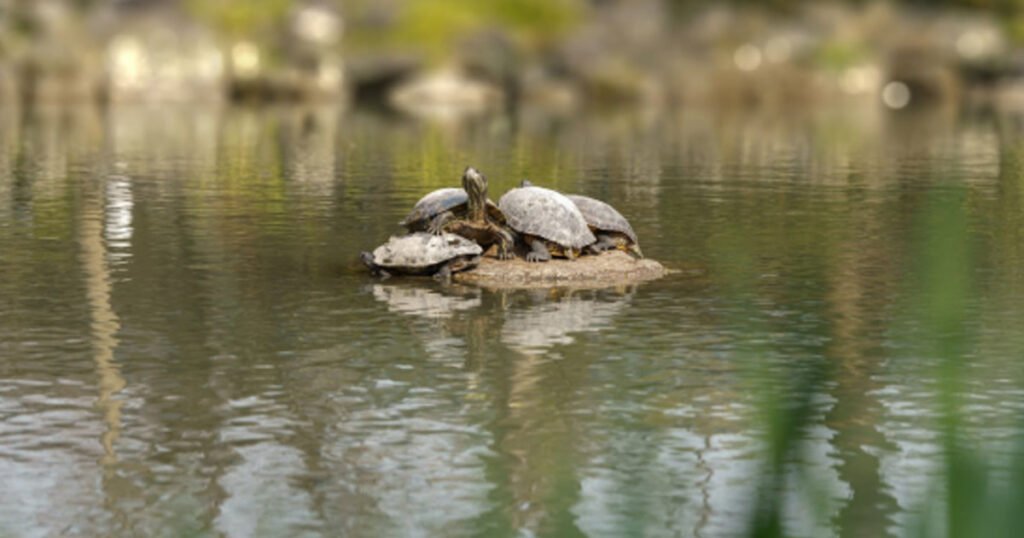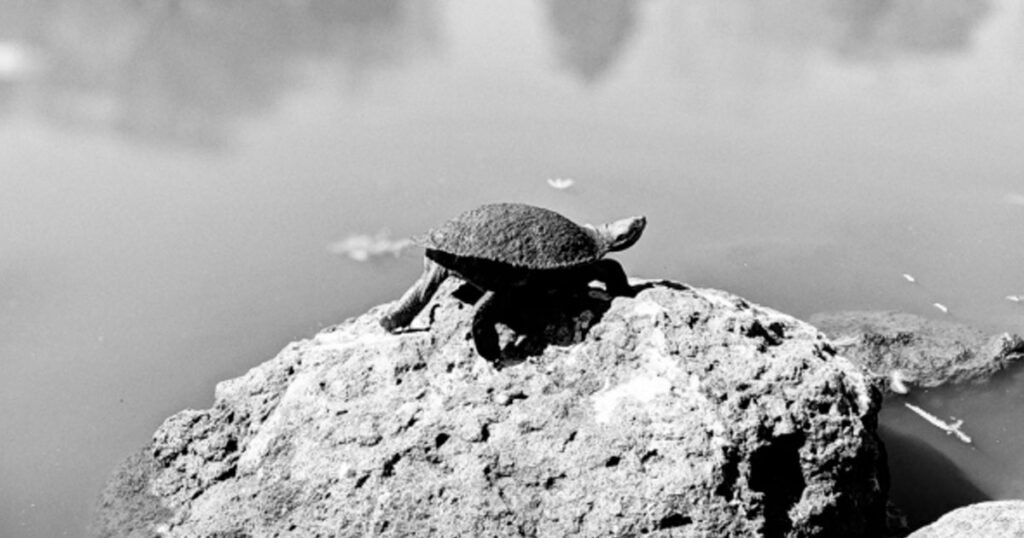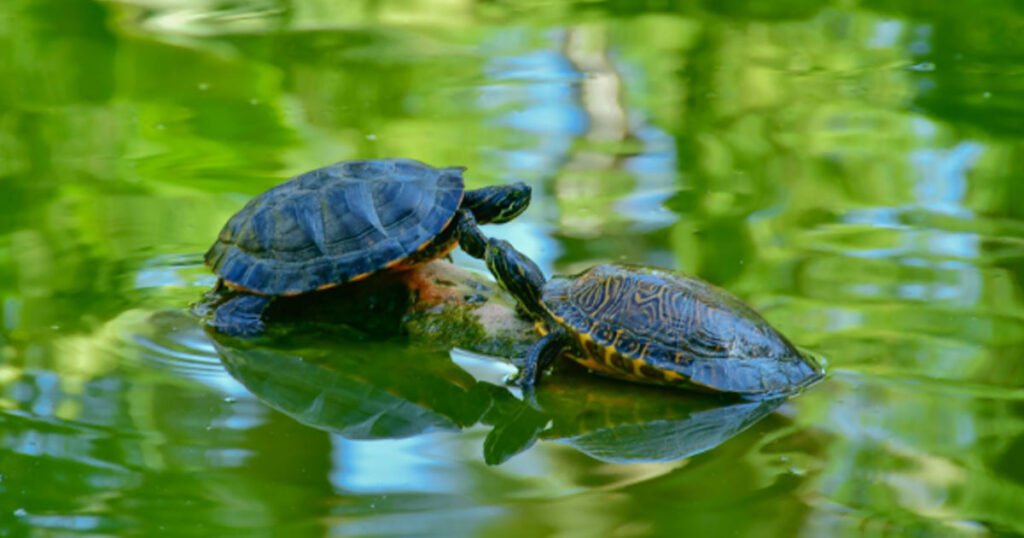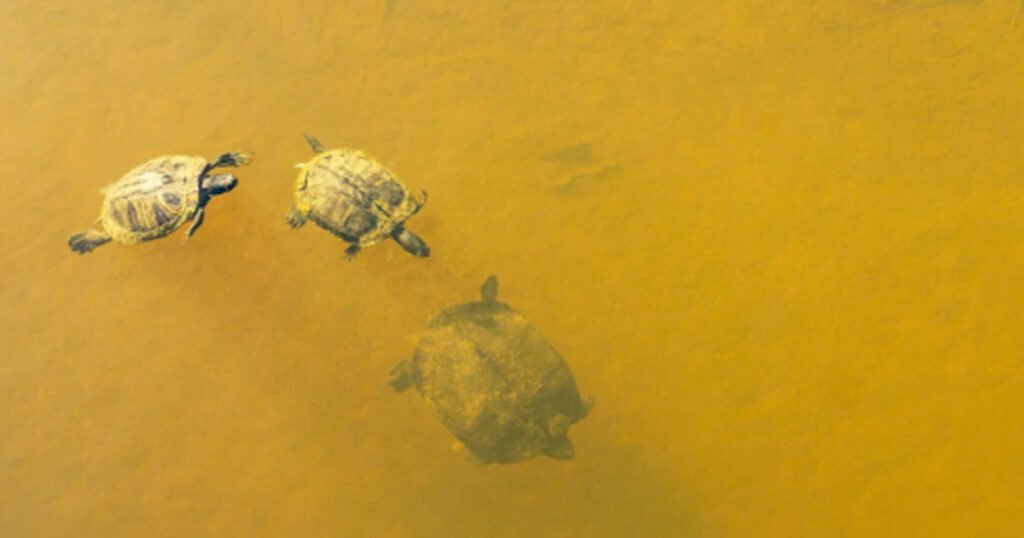Turtles can live in both freshwater and ocean environments because they have cold blood. Although they can live in both deep and shallow water, they like to stay close to the shore because the sun keeps them warm. Turtles like to eat fish, frogs, insects, snails, slugs, and other small animals that live near the water’s surface. They will also happily eat different kinds of plants.
The type of environment a turtle lives in affects what it eats. Let’s look at what to feed pond turtles. And what you should and shouldn’t feed turtles that you keep as pets in your pond.
Table of Contents
What To Feed Pond Turtles

So, what to feed turtles in a pond? In ponds, turtles eat a lot of different things, like plants, bugs, veggies, and crabs. Both plant and animal foods are good for them, though each type has its specific diet.
Its food habits depend on where it lives, how big it is, how old it is, and what breed it is. In simple terms, they are opportunistic omnivores, which means they will eat anything that can be made for them quickly and easily.
These are some of the items that the turtles like to eat:
Lilies of the water
When you put water on top of lilies, they float. Their roots stay at the bottom of the pond or river, where they get food from the mud and dirt. These are the different kinds:
- Red-purple water lilies.
- Green spider flowers.
- White water flowers.
- Yellow water flowers.
- White water flowers.
Turtles love to eat these plants in ponds because they are high in calcium. These foods also have iron, manganese, copper, vitamin C, and potassium, all of which help them get big and strong.
Turtles love to eat water lilies because most other animals in the pond can’t. The leaves are also very healthy for them.
Celery in Wild
Wild celery grows well in both freshwater and sea, so turtles can find it almost anywhere there is water. Turtles love to eat both the water celery and the rough-stemmed wild celery.
Turtles love wild celery because it is full of healthy things like vitamin A, potassium, calcium, iron, and magnesium. There is no need for your pond to be in a sunny spot for wild celery to grow well. The water will give it what it needs.
The Duckweed
In a pond, turtles love to eat duckweed more than any other type of plant. It lives almost everywhere there is water, so your pond turtle will probably be able to find some. There are many kinds of these plants, such as curly-leaf and fuzzy white duckweed.
Duckweed grows well almost anywhere, which is why turtles love it. It also has a lot of good things for turtles, like iron, calcium, and phosphorus, which help them get big and strong.
Watercress
Turtles love to eat watercress, which is a type of plant that grows in water. That is, this type of plant can grow in both freshwater and sea. It will grow anywhere there is water. The Curly cress, the Broadleaf cress, and the Garden cress are some of the different types.
This plant is very tough because it can grow almost anywhere. This plant also has a lot of vitamin C, which means turtles will get big and strong.
Plantain Arrowhead
Arrowheads grow well in wet places, so it’s likely that your turtle will find them in the pond.
There are two kinds of arrowhead plantains that turtles love to eat: those with broad leaves and those with thin leaves. There are also a lot of vitamins A and C in these plants, which help turtles get big and strong. Their shells stay hard because they have a lot of iron.
Dandelions
As long as there is water, dandelions can grow almost anywhere. This means that your turtle will probably find them at the pond. There are different kinds of these plants, like white clover, red-purple dandelions, and yellow dandelions.
Turtles love dandelions because they are full of good things for them, like calcium, potassium, and manganese.
Flowers from Cardinal
With their sharp leaves that rise above the water, these plants are likely to be near the pond where your turtle lives. Coral flowers, both red and white, are great for turtles to eat because they are high in calcium and phosphorus.
Cardinal flowers have many healthy nutrients and minerals in them, like sulfur and iron. Also, because they are so tall, they won’t let too many weeds grow in your lake. This makes it easy to pull out any that you don’t want by hand.
Canary Grass Reed
This plant grows well in both freshwater and saltwater, so it’s likely that your turtle will find it in the pond.
Turtles like to eat both red-purple and green reed canary grass. These are healthy foods because they are high in potassium, iron, and manganese.
You can get a lot of vitamins and nutrients, such as calcium, magnesium, and zinc, from these plants. These plants are also hardy because they can grow anywhere there is some water.
What to Feed Pond Baby Turtles?

Baby pond turtles usually need the same kinds of food as adult turtles, though because they are smaller and their jaws aren’t fully formed yet, they may need smaller or softer foods. These are some things that baby pond turtles often eat:
- Commercial turtle food: At pet shops, you can find pellets or sticks made just for aquatic turtles. These are often made better by adding important nutrients.
- Small live or frozen prey: Baby pond turtles may eat small live or frozen prey like mealworms, crickets, minnows, guppies, or other watery invertebrates.
- Greens with leaves: Give them leafy greens like kale, collard greens, or spinach that have been chopped up small. These give you minerals and vitamins that your body needs.
- Fruits and vegetables: As treats every once in a while, give your pet small amounts of finely chopped fruits and veggies, like squash, cucumbers, or carrots.
- Commercial turtle treats: Some pet stores sell turtle treats like mealworms or dried shrimp that are sold in stores. These should only be given as treats and not as regular meals.
Feeding Pond Turtles: What to Avoid?

Your pond turtle will probably eat anything, but some things are bad for them that you should stay away from.
Here are some ways to get the best of both worlds.
- No Oily Food: Don’t give your turtle any greasy food. No French fries, donuts, onion rings, or other things like those will be served.
- No Dairy Foods: No dairy foods, like milk, cheese, butter, and so on. Turtles don’t have the enzymes they need to break down lactose properly.
- Sugary Foods: You can’t have any candy, chocolate, or other sweet foods. Not only is it bad for the turtle’s health, but these things are often hard and could cause your pet to choke.
- Don’t Kiss: Please don’t kiss your turtle. They are cute when they are young, but they can make you sick with Salmonella, and you don’t want your turtle to make you sick.
How to Set Up an Outdoor Turtle Pond

Building an outdoor turtle pond can be fun and gives your turtles a great place to live that is both natural and large. To help you get started, here’s a simple list:
- Select an Appropriate Location: Pick a spot in your yard that gets a lot of sun but also has some shady spots for when it gets too hot. Make sure the area is level and doesn’t have any dangerous animals or plants that could hurt you.
- Plan the Size and Shape: The number and types of turtles you want to keep will help you decide the size and shape of your pond. Keep in mind that turtles need a lot of room to swim and layout.
- Dig the Pond: To make the pond, dig the area. There should be different depths, with small spots for sunbathing and deeper ones for swimming. Include ramps or sloped places that make it easy for the turtles to get in and out.
- Install a Pond Liner: Cover the hole you dug with a strong pond liner to keep water quality high and stop leaks. Make sure the liner goes past the pond’s sides to keep it in place.
- Add Filtration and Aeration: To keep the water clean and healthy for your turtles, put in a good filtration system. Adding oxygen to the water can also be done with pumps or streams.
- Create bathing Areas: Add rocks or bathing platforms to the pond to give the turtles dry places to rest and keep their body temperature stable. Make sure that these places are easy to get to from the water.
- Choose Water Plants: Add water plants to the pond, such as water lilies, duckweed, or water hyacinths. They not only make the pond look better, but they also give the turtles a place to live and help keep the water clean.
- Substrate: You might want to put something like smooth river rocks or fine gravel on the bottom of the pond as a substrate. This can create a more natural environment for the turtles by making it look like their original habitat.
- Set up Hiding Spots: To give the turtles a place to hide, put logs, driftwood, or man-made holes in the pond. This makes things more interesting and helps lower stress.
- Check Water Parameters: Check the temperature, pH, ammonia, nitrite, and nitrate amounts, as well as other water quality parameters, regularly. As needed, do partial water changes to keep things running at their best.
- Protect the Pond: Put up a strong fence or wall around the pond to keep turtles in and keep animals out.
- Introduce Turtles: Once the pond is fully set up and running, slowly introduce your turtles to their new home outside. Watch how they act and make sure they get used to the surroundings well.
Read More: How Many Eggs Can A Turtle Lay
Conclusion
What to feed pond turtles? You can keep turtles in a pond, and they’ll eat a lot of weeds, which keeps the water clean. Just make sure your turtle can get to plants that are high in nutrients, like arrowhead or canary grass.
